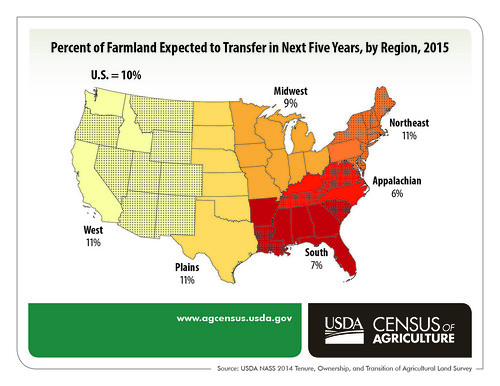
Whether they farm the land themselves or rent it out to others to farm, those who own agricultural land are taking measures to keep the land in their families. This is good news for those who worry about the United States losing agricultural land to competing pressures.
At USDA’s National Agricultural Statistics Service, we just released the findings from a survey of agricultural landowners conducted earlier this year. It confirmed some things we know already and generated lots of new information that farmers, policymakers, businesses and others will use to understand more about who owns farmland, who has and will have access to farmland in the future, what kinds of conservation and production decision landowners are making, and lots more.
This is the first time this much information about agricultural landownership is available since NASS conducted a similar survey in 1999. We know from the Census of Agriculture that the United States has more than 900 million acres of farmland – two fifths of all our land. The new survey, called the 2014 Tenure, Ownership, and Transition of Agricultural Land (TOTAL) survey, tells us a lot about the 39 percent of farmland – some 354 million acres – that landowners rent out for agricultural purposes.
These “acres rented out,” as we call them, are owned both by farmers who rent them to other farmers and ranchers and non-farming landlords, who may be individuals or participants in a partnership, trust, corporation, or other arrangement. Farming landlords account for 20 percent of acres rented out, and non-farming landlords account for 80 percent.
The total value of the land rented out (including the buildings on the land) was $1.1 trillion in 2014. Landlords collectively received $31.2 billion in rental payments against expenses of $9.2 billion – their expenses on average were less than 30 percent of the rent received. And most acres rented out were fully paid for. This was true for both farming and non-farming landlords.
How is the rented agricultural land used? Sixty-three percent was for growing crops and 34 percent was used as pasture for livestock (the rest was buildings, ditches, ponds, etc.). But in addition to renting out the land, landlords also lease or sell various rights, including mineral rights, recreational rights, development rights, and wind rights.
An important set of information to come from this new survey relates to landowners’ future plans. TOTAL asked landowners what they plan to do with all their land, not just the land they rent out. Out of all U.S. farmland, about 10 percent, or 91.5 million acres, is expected to transfer to new ownership in the next five years, with the Northeast, Plains, and West regions transferring larger shares than the U.S. average or other regions. Almost half of the land transfer will take place through trust arrangements.
NASS conducted the TOTAL survey in partnership with USDA’s Economic Research Service, which plans to use the data in a wide range of upcoming economic studies. We are excited about the value that the data will bring to many policy and research questions. You can access the newly released data on the NASS TOTAL web page, where you will find national and regional data, as well as detailed information on 25 states and many topics. Check it out. I think you will find lots of useful and interesting information about U.S. farmland and landowners.
